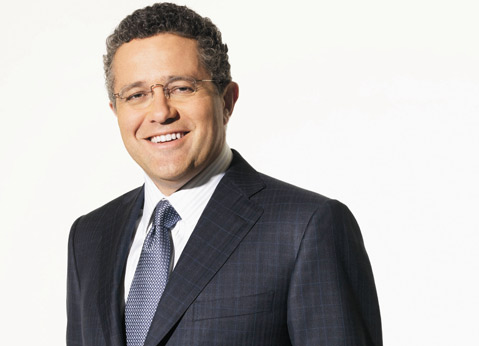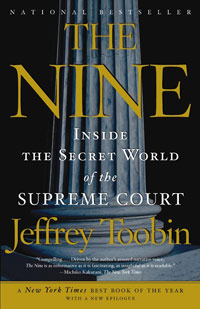Jeffrey Toobin to Speak at UCSB
Legal Analyst Exposes the Inner Workings of the Supreme Court

How forbidding the Supreme Court is: a plane apart from normal human affairs, a rarefied sphere where nine hugely empowered, intellectually perfect justices, clad in the finest robes tax dollars can buy and deeply immured in their stark quarters, strenuously ponder the toughest, most implication-laden legal decisions ever to arise. Maybe that’s a slight exaggeration, but compared to the rest of the United States government, the Supreme Court practically is an underground operation. CNN legal analyst and New Yorker staff writer Jeffrey Toobin is one of those rare individuals not employed by the court who is able to get a good look at its inner workings. His national bestseller, The Nine: Inside the Secret World of the Supreme Court, responded to the public’s growing thirst for knowledge about the few whose opinions affect the lives of so many. On November 13, he’ll pay a visit to UCSB to discuss issues facing the Supreme Court in the wake of this year’s election.

Though not everything Toobin found while researching lined up with the caricature of the Supreme Court as a realm of modern-day philosopher kings, he admitted that gaining access to it could be a struggle. “Getting inside there was the biggest reporting challenge of my life,” Toobin said over the phone from his New York office. And the institution is no longer as secretive as it once was in earlier, more media-free times. “You just have to hope that they care about how the court is perceived,” he explained. “I think that there has been some generational change. The younger justices have grown up in a world with a lot more public scrutiny, and that’s not a terrible or shameful thing; it’s just how the world works. They recognize that the court needs to explain its functions to the public in a more modern way. Given how controversial the court’s decisions are, it’s often the case that they would like to explain what they’re doing.” Toobin’s book provided an outlet for such explanations.
The Nine opens with and is centered on one particular moment in the Supreme Court’s history: the September 2005 death in office of Chief Justice William Rehnquist. “The court in 2005 had had no change in membership for 11 years,” said Toobin. “That was the longest time in the history of the Supreme Court that nine justices have remained together without change. You had two justices, Sandra Day O’Connor and Rehnquist, leave in quick succession, and now it’s a new court that reflects George W. Bush’s policies and priorities. It’s a different place.” The Nine both doubles back in time to cover the nominations and appointments of several of the titular group’s justices and rolls ahead to describe those of the newest ones. Reading of the deliberation, the strategy, the vetting, and the deal-making that went on as John Roberts and Samuel Alito ascended to occupy the two vacant spots underscores the importance of the recent presidential election: with three justices liable to retire in the new president’s first term, the court may rapidly come to reflect an entirely different set of policies and priorities.
The future of the Supreme Court aside, many Americans are intensely curious about the pasts, personalities, and peculiarities of the justices themselves. For Toobin, the task of balancing personality and policy required a certain precision. “Personality reflects policy,” he said. “If you learn what these justices are like personally, you also learn their politics. Besides, no book is useful unless people want to read it, and so my top priority was to make the book readable and entertaining.” Which justices are readers most eager to learn about? Toobin named several: “Justice [Antonin] Scalia, who is pugnacious in person and in print. Justice [David] Souter, who leads a sort of 19th-century lifestyle without a computer or cell phone, yet wrote the most technologically sophisticated opinion in the Grokster case about filesharing over the Internet.” But Sandra Day O’Connor draws more reader fascination than any of her colleagues, and it’s a fascination Toobin clearly shares. “She’s the central figure in my book. She was the first woman in the court, she wielded enormous power as the swing vote, which she often actively sought out, and she steered the court with great skill.”
The Supreme Court is sometimes called the least democratic institution in the United States, and, due to that remove from the electorate, the most apolitical as well. Toobin agrees strongly with the former assertion but disagrees just as strongly with the latter. “It’s certainly antidemocratic,” he said. “The justices are not elected, nor are they accountable in any meaningful way. They can essentially do anything they want and serve for life, but because they’re honorable people, they exercise that enormous power with restraint, for the most part. I think they exercise that non-democratic power in a democratic way. I certainly do not believe that the court is apolitical. Politics is at the heart of what they do. I don’t think that’s a criticism of the justices; I think that’s just a fact about the nature of the cases before them. There’s no apolitical way of deciding issues like abortion, affirmative action, and church-state relations. Those issues are inherently political. It’s simply a fact of life.”
4•1•1
Jeffrey Toobin will speak at UCSB’s Campbell Hall on Thursday, November 13, at 7:30 p.m. For tickets or more information, call 893-3535 or visit artsandlectures.ucsb.edu.



